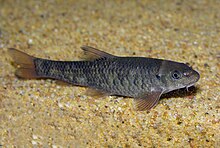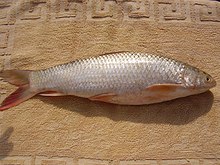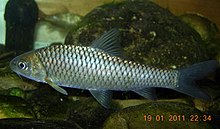コイ亜科
| コイ亜科 | |||||||||||||||||||||
|---|---|---|---|---|---|---|---|---|---|---|---|---|---|---|---|---|---|---|---|---|---|

| |||||||||||||||||||||
| 分類 | |||||||||||||||||||||
| |||||||||||||||||||||
| 学名 | |||||||||||||||||||||
| Cyprininae Rafinesque, 1815 |
コイ亜科 Cyprininae は、コイ科の亜科の一つ。主にユーラシア大陸南部からアフリカの淡水域に分布する。コイ科では最大の亜科であり、およそ1300種を含む[1]。
分類[編集]
11族に分けられる[1]。種数はFishBaseによる[2]。
Probarbini[編集]

Probarbini Lei et al., 2015 - 東南アジア産。
- Probarbus - 3種
- Catlocarpio - 1種 パーカーホ
ラベオ族[編集]



Labeonini - 約34属400種を含む。アフリカ・アジアの熱帯域に分布する。多くの種は渓流域に生息し、口の形態が特殊化しているものが多い[3][4][5][6]。
- Labeoina Bleeker, 1859
- Gymnostomus
- Incisilabeo
- ツノゴイ属 Bangana - 24種
- Schismatorhynchos - 4種
- ラベオ属 Labeo - 103種
- ケンヒー属 Cirrhinus - 11種 ケンヒー
- Garraina Bleeker, 1863
- アゴヒラ属 Garra - 112種 ドクターフィッシュ
- Phreatichthys - 1種[7]
- Horalabiosa - 3種
- Iranocypris - 1種[8]
- Paracrossochilus - 2種
- Gonorhynchus (syn. Akrokolioplax - 1種)
- Sinigarra - 1種[9]
- アゴヒラ属 Garra - 112種 ドクターフィッシュ
- Osteochilina - 主に東南アジア
- エパルゼオリンコス属 Epalzeorhynchos - レッドテールブラックシャーク
- Crossocheilus - 16種
- Henicorhynchus - 4種
- Lobocheilos - 23種
- Barbichthys - 1種
- Thynnichthys - 4種
- Labiobarbus - 9種
- カタクチ属 Osteochilus - 35種
- Semilabeoina - 主に中国
- Ageneiogarra
- Placocheilus - 5種
- Mekongina - 3種
- Linichthys - 1種
- Discogobio - 16種(Discocheilus 2種を含む)
- Sinocrossocheilus - 2種
- イシツキウオ属 Pseudogyrinocheilus - 2種
- Discolabeo - 1種
- Qianlabeo - 1種
- Stenorynchoacrum
- Rectoris - 5種
- Hongshuia - 3種
- フサモロコ属 Ptychidio - 3種
- Parasinilabeo - 6種
- Semilabeo - 2種
- Cophecheilus - 1種
- Pseudocrossocheilus - 6種
- Incertae sedis
- Longanalus - 1種
- Parapsilorhynchus - 4種
- Protolabeo - 1種
- Sinilabeo - 6種
- Typhlogarra - 1種
- Hemigrammocapoeta - 4種
- Prolabeo - 1種
- Prolabeops - 2種
- Diplocheilichthys - 2種
Torini[編集]

Torini Karaman, 1971 - アジア、アフリカ産の大型種を含む。アジア産種(Tor 属など)の方が基底的だと考えられる。
- Lepidopygopsis - 1種
- Hypselobarbus - 10種
- Osteochilichthys - 2種
- Neolissochilus - 23種
- Naziritor - 1種
- Tor - 20種
- Carasobarbus - 5種
- Kosswigobarbus - 1種[10]
- Varicorhinus - 37種 アフリカ[11]
- Acapoeta - 1種 Varicorhinus から分割[11]
- Labeobarbus - 43種
- Mesopotamichthys - 1種
- Sanagia - 1種
Smiliogastrini[編集]

Smiliogastrini Bleeker, 1863 - アジア・アフリカに産する小型種のグループ。
- Chagunius - 3種
- Oreichthys - 3種
- Osteobrama - 10種
- Sahyadria - 2種
- Dawkinsia - 9種
- Striuntius - 1種
- Oliotius - 1種
- Barbodes - 39種
- Hampala - 7種
- Puntigrus - 5種
- Desmopuntius - 7種
- Rohtee - 1種
- プンティウス属 Puntius - 67種
- Haludaria - 4種
- Pethia - 34種
- Systomus - 13種
- Barboides - 2種
- Pseudobarbus - 7種
- Clypeobarbus - 7種
- Ospatulus - 2種[12]
Poropuntiini[編集]

Poropuntiini - 主に東南アジアに分布する。
- Eirmotus - 4種
- Discherodontus
- Cyclocheilos
- バランティオケイロス属 Balantiocheilos - 2種 シルバーシャーク
- Cosmochilus - 4種
- Amblyrhynchichthys - 2種
- Puntioplites - 4種
- Albulichthys - 1種
- Cyclocheilichthys - 10種
- Barbonymus - 5種
- Scaphognathops - 3種
- Sawbwa - 1種 レッドフィンレッドノーズ
- Poropuntius - 40種
- Hypsibarbus - 10種
- Sikukia - 4種
- Mystacoleucus - 8種
コイ族[編集]

Cyprinini Rafinesque, 1815 - ユーラシアに産するグループ。
- Procypris - 2種
- Luciocyprinus - 2種
- コイ属 Cyprinus - 23種 コイ(野生型・飼育型)
- ヒゲブナ属 Carassioides - 3種
- フナ属 Carassius - 4種 ゲンゴロウブナ・フナ類(キンブナ・ギンブナ・ニゴロブナ・オオキンブナ・ナガブナ)・(キンギョ)・ヨーロッパブナ
- Sinocyclocheilus (syn. Anchicyclocheilus) - 57種 雲貴高原のカルスト台地に分布、洞窟性種を含む[13]。
- Aaptosyax - 1種[14]
- Troglocyclocheilus - 1種
- Xenobarbus - 1種

ハナマガリ族[編集]
Acrossocheilini Lei et al., 2015 - 東南アジアから中国。
- クチマガリ属 Onychostoma - 21種
- ハナマガリ属 Acrossocheilus - 24種
- キツネニゴイ属 Folifer - 1種

セイバンゴイ族[編集]
Spinibarbini Lei et al., 2015 - 東アジアに分布する1属のみを含む。
- セイバンゴイ属 Spinibarbus - 10種
Schizothoracini[編集]

Schizothoracini McClelland, 1842 - アジアの高原地帯で見られる。
- シセンアブラハヤ属 Schizothorax - 65種
- Schizopyge - 2種
- Percocypris - 3種
- Aspiorhynchus - 1種
- Racoma - 1種[15]
Schizopygopsini[編集]
Schizopygopsini Mirza, 1991 - アジアの高原地帯で見られる。
- Diptychus - 2種
- Gymnodiptychus - 3種
- Ptychobarbus - 4種
- Oxygymnocypris - 1種
- Platypharodon - 1種
- ハダカゴイ属 Gymnocypris - 10種
- Schizopygopsis - 8種
- Chuanchia - 1種
- Herzensteinia - 1種
Barbini[編集]

Barbini Bleeker, 1859 - ユーラシア大陸とアフリカ北西部。
- Scaphiodonichthys - 3種
- Cyprinion - 10種
- Semiplotus - 3種
- Aulopyge - 1種
- Barbus - アンゴラ・バーブ
- Luciobarbus - 22種
- Capoeta - 24種
Incertae sedis[編集]
- Schizocypris - 3種
- Barbopsis - 1種
- Caecobarbus - 1種
- Coptostomabarbus - 2種
- Kalimantania - 1種
- Laocypris - 1種
- Neobarynotus - 1種
- Parasikukia - 1種
- Paraspinibarbus - 1種
- Parator - 1種
- Rohteichthys - 1種
- Typhlobarbus - 1種
系統[編集]
次のような系統樹が得られている[1]。
| |||||||||||||||||||||||||||||||||||||||||||||||||||||||||||||
脚注[編集]
- ^ a b c Yang, Lei, et al. (2015). “Phylogeny and polyploidy: Resolving the classification of cyprinine fishes (Teleostei: Cypriniformes)”. Molecular phylogenetics and evolution 85: 97-116. doi:10.1016/j.ympev.2015.01.014.
- ^ “cyprinidae in fishbase”. 2015年3月14日閲覧。
- ^ Lei Yang, Richard L. Mayden (2010). “Phylogenetic relationships, subdivision, and biogeography of the cyprinid tribe Labeonini (sensu Rainboth, 1991) (Teleostei: Cypriniformes), with comments on the implications of lips and associated structures in the labeonin classification”. Molecular Phylogenetics and Evolution 54 (1): 254–265. doi:10.1016/j.ympev.2009.09.027.
- ^ Lanping ZHENG, Junxing YANG, Xiaoyong CHEN, Phylogeny of the Labeoninae (Teleostei, Cypriniformes) based on nuclear DNA sequences and implications on character evolution and biogeography 2012年11月10日閲覧。
- ^ Xuzhen Wang, Junbing Li, Shunping He (2007). “Molecular evidence for the monophyly of East Asian groups of Cyprinidae (Teleostei: Cypriniformes) derived from the nuclear recombination activating gene 2 sequences”. Molecular Phylogenetics and Evolution 42 (1): 157–170. doi:10.1016/j.ympev.2006.06.014.
- ^ Lei Yang, Richard L. Mayden, Tetsuya Sado, Shunping He, Kenji Saitoh, Masaki Miya (2010). “Molecular phylogeny of the fishes traditionally referred to Cyprinini sensu stricto (Teleostei: Cypriniformes)”. Zoologica Scripta 39 (6): 527–550. doi:10.1111/j.1463-6409.2010.00443.x.
- ^ Licia Colli, Annalisa Paglianti, Roberto Berti, Gilberto Gandolfi, James Tagliavini (2009). “Molecular phylogeny of the blind cavefish Phreatichthys andruzzii and Garra barreimiae within the family Cyprinidae”. Environmental Biology of Fishes 84 (1): 95-107.
- ^ Hashemzadeh Segherloo, I., et al. (2012). “Genetic differentiation between two sympatric morphs of the blind Iran cave barb Iranocypris typhlops”. Journal of fish biology 81 (5): 1747-1753. doi:10.1111/j.1095-8649.2012.03389.x.
- ^ Zhang, E., and Wei Zhou. (2012). “Sinigarra napoense, a new genus and species of labeonin fishes (Teleostei: Cyprinidae) from Guangxi Province, South China”. Zootaxa 3586: 17-25.
- ^ Durand, J-D., et al. (2002). “Phylogeny and biogeography of the family Cyprinidae in the Middle East inferred from cytochrome b DNA—evolutionary significance of this region”. Molecular Phylogenetics and Evolution 22 (1): 91-100. doi:10.1006/mpev.2001.1040.
- ^ a b Levin, B. A. (2012). “New data on morphology of the African scraping feeder Varicorhinus beso (Osteichthyes: Cyprinidae) with the special reference to specialized traits”. Journal of Ichthyology 52 (11): 908-923. doi:10.1134/S0032945212110069.
- ^ Pethiyagoda, Rohan, Madhava Meegaskumbura, and Kalana Maduwage (2012). “A synopsis of the South Asian fishes referred to Puntius (Pisces: Cyprinidae)”. Ichthyological Exploration of Freshwaters 23 (1): 69-95.
- ^ Xiao, Heng, et al. (2005). “Molecular phylogeny of Sinocyclocheilus (Cypriniformes: Cyprinidae) inferred from mitochondrial DNA sequences”. Molecular phylogenetics and evolution 36 (1): 67-77. doi:10.1016/j.ympev.2004.12.007.
- ^ Yoshio Tomoda (2011). “A note on Aaptosyax grypus, a very rare, unique cyprinid fish”. Ichthyological Research 58 (3): 288-290.
- ^ Chen, Zi-Ming, and Yi-Feng Chen. (2001). “Phylogeny of the specialized schizothoracine fishes (Teleostei: Cypriniformes: Cyprinidae)”. ZOOLOGICAL STUDIES-TAIPEI- 40 (2): 147-157.
